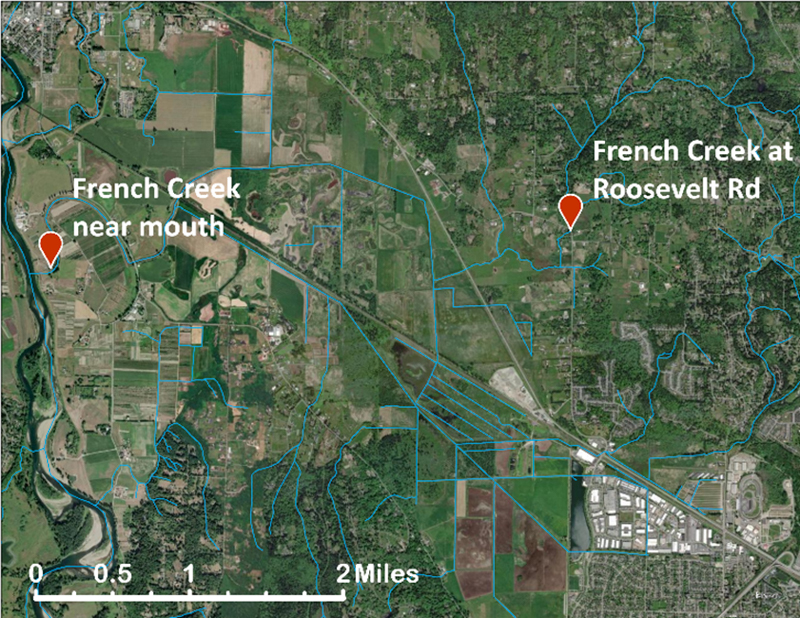
French Creek (Google Earth, 2021)
For the past few summers, neighbors along French Creek in Snohomish County have been noticing an intriguing change — an unusual orange hue in the stream, particularly where it flows into the Snohomish River. This peculiar color shift has sparked curiosity and concern among the community.
Our investigative efforts have pointed towards a possible culprit: blue-green algae.
So, what’s going on here?
We attempted to shed some light on the situation by collecting water samples from French Creek during the summer and fall of 2022. We sampled both upstream and downstream in the creek, testing for several factors that might be contributing to the orange water.
Map of sampling locations along French Creek
Based on our samples, a likely cause of the discoloration is blue-green algae (cyanobacteria), the main species being Cuspidothrix. These algae sometimes make pigments that turn the water orange and can also produce toxins harmful to humans and animals.
Our study also found that suspended organic matter and iron-rich materials might be contributing to the water’s color as well, especially during the summer and fall, but our research shows that it likely isn’t the only cause.
How can we prevent algal blooms?
Samples taken from the downstream site also showed signs of higher nutrient levels. Nutrients such as nitrogen and phosphorus can get into a stream from excess fertilizer, manure, septic systems, and wildlife. This can be a large contributing factor to increasing algae growth — leading to more frequent and severe algal blooms.
To protect pets and livestock while improving water quality for the community, consider putting the following actions into practice.
Help livestock stay safe by keeping them away from the creek. This helps prevent them from drinking potentially unsafe water. It also helps to keep manure and other pollutants out of the water. Installing a fence helps to guarantee restricted access to the stream.
Consider planting vegetation along the creek. This natural filter helps to capture pollutants before they enter the water. Native trees help shade the creek, slowing down algae growth and improving water quality.
Keep excess nutrients like nitrogen and phosphorus from going into the water. Reducing nutrient runoff from lands where fertilizer and manure are applied, and properly maintaining septic systems can significantly decrease the rate of growth and severity of algal blooms.
Following these steps helps safeguard the environment and contribute to healthier water in French Creek.
How to access support for water quality improvement and algae control
For property owners and farmers in the area, several resources are available to help with these efforts. The Snohomish Conservation District offers free farm planning visits to help with nutrient management and other improvements. Interested individuals can visit their website or call 425-335-5634 for more information.
Dairy nutrient management planning
Washington Nutrient Management Planning provides guidance specifically for dairy farmers and other producers; they can be reached at 360-526-2381, ext. 105.
Reporting and testing algal blooms
If there are concerns about algal blooms affecting health or safety, individuals should call the Snohomish County Water Quality Hotline at 425-388-6481. For algal blooms outside of Snohomish County, contact the environmental health section of your local health department.
Stay informed
For more information on keeping our waterways healthy, check out resources like our Washington Waters - Ours to Protect page. Implementing these measures will help us to collectively improve the water quality in French Creek and ensure a safer environment for everyone.
If you have any questions about French Creek, contact Sarah Yepez at sarah.yepez@ecy.wa.gov or call 425-758-5095.

